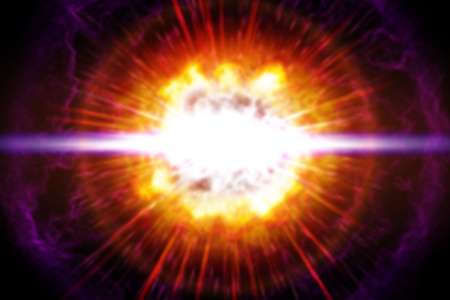New Class Of Supernova Discovered. Space Swoon!

There’s been a new class of supernova discovered. These sexy new entries into the catalog of Man’s Knowledge live-longer and burn brighter than the previously known novae. Resisting Energizer Bunny Joke.
io9:
The Palomar Transient Factory uses the telescopes at the Palomar Observatory to scan the skies, looking for flashes of light. The flashes could be flares, or friendly aliens saying hello in Morse Code, but often they are supernovae. In the late 2000s a group of supernovas appeared that were a little . . . off. They were bluer than most, and their light showed that they didn’t have the same chemistry as other supernovae.
Each separate chemical element emits and absorbs certain wavelengths of light. Chemists, and astronomers, analyze the light of glowing substances to see what wavelengths are given off. They use these wavelengths to figure out what elements the substance is made of. These blue novae had no hydrogen. Hydrogen is the lightest chemical element there is. It’s everywhere in the universe, and should abundant in a supernova, but these novae lacked the substance entirely. Were these four anomalies? There didn’t seem to be other novae with the same chemical composition.
That is, until researchers checked back through earlier records. In 2007, the brightest nova yet recorded, 2005ap, had just made the news. It also gave off an unusual set of wavelengths of light, but not one that matched the supernovae discovered by the PTF. When scientists shifted the spectrum slightly, allowing for the redshift added to the more distant objects in the universe, the spectra matched. These were a new class of supernovae, and they were bright.
They were also long-lived. Although the PTF looked for ‘flashes’ in the sky, but these novae glowed for about fifty days. Most supernovae glow through radioactive decay, and so darken relatively quickly. These new ones had to be fueled by something else. And this myserious something has to only appear in dwarf galaxies, the only galaxies these supernovae have been observed in.
Some scientists believe the novae are just superhuge stars that have blown off their hydrogen before they go nova. Others believe that they are the result of ‘magnetars,’ rapidly spinning objects, whose equally rapidly changing magnetic fields cause the charged particles in space to glow. Other than that, there isn’t much we know about these new supernovae, except that they’re out there.
Super-powered supernovae! Scientific speculating! Conjecture! The wonder of space, yo.



